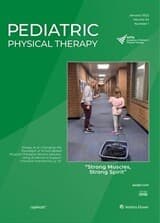Science
Interviews in this edition: 1. Andrea Baraldi Cunha, Research Associate, Department of Physical Therapy, Biomechanics & Movement Science Program, University of Delaware, Newark, DE. Title: “A Novel Means-End Problem-Solving Assessment Tool for Early Intervention: Evaluation of Validity, Reliability, and Sensitivity” Introduction: A new, simple tool could potentially help screen for motor delay quickly and easily. The “Means-End Problem-Solving Assessment Tool”—MEPSAT for short—has been assessed by comparing a group of children with developmental delay with a control group who were typically developing. 2: Halil Alkan PT, PhD, Physical Therapist, Muş Alparslan University, Muş and Hacettepe University, Ankara, Turkey. Title: “Early Spontaneous Movements of Infants With Hypoxic-Ischemic Encephalopathy” Introduction: Hypoxic ischemic encephalopathy investigated in 38 infants between three and five months old and compared with typically developing children and scored for a range of indicators of motor delay found Halil Alkan hypoxic brain injury was strongly associated with the overall adequacy of infants’ motor repertoires, and the frequency of their so-called “fidgety movements”. 3: Casey (Mary C) Hooke PhD, University of Minnesota School of Nursing, Minneapolis, Minnesota Title “Testing the Child PROMIS Physical Activity Measurement in Youth Attending a Large Community Event” Introduction Patient-reported outcome measures were successfully used to assess health-care interventions, by collecting data from child-patients using the system known as: PROMIS — the Child Patient Reported Outcomes Measurement Information System. 4: Gunfrid Vinje Størvold, PT PhD, Department of Habilitation, Levanger Hospital, Nord-Trøndelag Hospital Trust, Levanger, Norway Title: “Current Physical Therapy Practice in Norway for Children With Cerebral Palsy” Introduction: A survey of real-world pediatric physical therapy practice for cerebral palsy in Norway found strong adherence to recommended evidence-based practice. 5: Marcelo R Rosales, Biokinesiology Program, Infant Neuromotor Control Laboratory, University of Southern California, Children's Hospital, Los Angeles, CA Title: Collecting Infant Environmental and Experiential Data Using Smartphone Surveys Introduction: Promising early research has found smartphones could help physical therapists monitor infant development in a range of clinical situations. 6: Brittany Anderson PT DPT, Associate Professor in Physical Therapy, University of Jamestown, Fargo, ND Title: Using a 3D-Printed Prosthetic to Improve Participation in a Young Gymnast Introduction: A prosthetic hand that can grip, inexpensively customised with the help of a 3-D printer, helps a nine-year old girl do gymnastics despite her lack of functioning fingers on one of her hands. 7: James Shanandore, Asst Prof of Anatomy & Physiology, Univ of Jamestown Physical Therapy Prog, Fargo ND Title: “3-D Printed Prosthetic Hand Helps Junior Gymnast: The Back Story” Introduction: How physical therapists can harness 3-D printing to individualise a functioning prosthetic hand. 8: Mary Gannotti PT PhD, Professor, Department of Rehabilitation Services, University of Hartford, West Hartford, CT, Research Scientist, Shriners Hospital, Springfield, MA Title: Designing Exercise to Improve Bone Health Among Individuals With Cerebral Palsy Introduction: Combining mechanical theory and practical experience can help young patients with cerebral palsy avoid painful morbidity late in life by directing good exercise patterns in pre-puberty and adolescence to specifically target the skeleton and rather than muscle alone.

